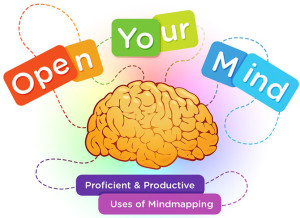Why Mindmapping is Better than Outlining by Meggin McIntosh, PhD
 I’ve been a big fan of mindmapping for many years – for many purposes. In graduate school I would use mindmapping as a way of consolidating and studying material that I was learning. As a speaker, I use mindmapping to help me plot out a workshop or keynote presentation. And definitely, as a writer, I use mindmapping constantly to assist me in generating and organizing my ideas – and to get me unstuck.
I’ve been a big fan of mindmapping for many years – for many purposes. In graduate school I would use mindmapping as a way of consolidating and studying material that I was learning. As a speaker, I use mindmapping to help me plot out a workshop or keynote presentation. And definitely, as a writer, I use mindmapping constantly to assist me in generating and organizing my ideas – and to get me unstuck.
Recently, I did a mindmap to answer the question, “Why mindmap?” because so many people are still new to this way of thinking about, generating, and organizing ideas. I’ve taken my mindmap and organized it as a top ten (linear format) here:
- Mindmapping taps into the creative portions of our brain. And don’t we all know we need those portions tapped into when we are writing?!
- Mindmapping is structured more like the brain is structured. When you see diagrams of the brain – with the neurons and dendrites – it looks like a mindmap. I have never seen a diagram representing the brain that looks like an outline. Our brains don’t work in a linear fashion, so trying to generate ideas linearly isn’t particularly productive.
- With mindmapping, it is so easy to just keep adding ideas to your map. With outlining, it is more difficult – plus there is always the nagging worry about whether something should be an A or an a – and that if there’s an A, there has to be a B. With mindmapping, you don’t spend any mental energy worrying about that.
- You can change the structure of your mindmap as needed. You can do this if you mindmap on paper (by hand, which is a FINE way and some would argue preferable) or if you mindmap using some of the excellent software. I happy to use Mindjet’s software for mindmapping when I’m not working by hand.
- Mindmapping feels (and is) less restrictive and less limiting than outlining. Just like with any other aspect of writing, you can edit later but during the generation and organization phases, it’s nice to be able to feel less restricted.
- When you are working with a partner on a project, a mindmap lends itself to collaboration more than an outline does. This is true whether you are working side by side or virtually. Generally, if you are working virtually, you will want to test out one of the web-based/cloud-based solutions for mindmapping (and there are many).
- Mindmapping helps you make connections that you would be less likely to make if you were just making a list or outlining. Just as your brain makes linkages between and among ideas, viewing a mindmap provides that opportunity as well. If you are writing a book or article and just can’t seem to make some elusive connection, see if a mindmap will make a difference for you.
- Most mindmaps can fit on one sheet of paper. So rather than reams of outlines, you can consolidate your thoughts – even for a whole book – on one page.
- Mindmaps can be adapted to be playful or serious, depending on your needs. Let your mindmaps reflect your writing personality and style. Adapt them when you are working on different projects. You’re not turning in your mindmap. It’s for you to use so you can write more fluently and cohesively.
- Mindmaps are an excellent way to get “unstuck.” We all hit a writing wall sometimes and if you will just recognize that, get out a fresh paper or the mindmap for the project you’re working on and start extending it and seeing the connections that are there, you will get unstuck. It works for me everytime.
If you haven’t tried mindmapping yet, I hope you will. Even if you think outlining works great for you, live it up! Try a mindmap (or two or three or twelve). It can’t hurt.
© Meggin McIntosh, Ph.D. (also known as “The PhD of Productivity”®). One of the ways that you can learn from Meggin about productive writing is through her 30 Articles in Just 30 Days program (www.30ArticlesinJust30Days.com).
 And to help you generate those ideas for your next writing project you will want to access the class Proficient & Productive Use of Mindmapping Open Your Mind! which offers ideas and strategies for how to integrate mindmapping into your thinking and problem-solving.
And to help you generate those ideas for your next writing project you will want to access the class Proficient & Productive Use of Mindmapping Open Your Mind! which offers ideas and strategies for how to integrate mindmapping into your thinking and problem-solving.




